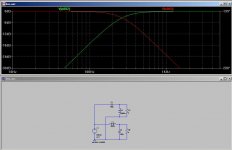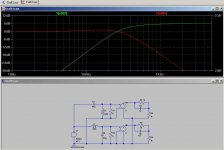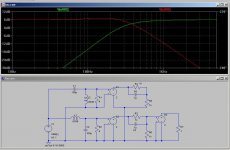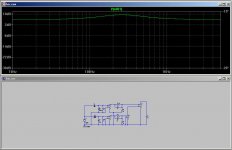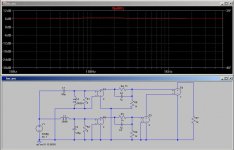tinitus said:
Well, I wonder where you got that value from, as 3.9mH may work as good as 3.6mH, or any other guess fore that matter...you really cant tell untill you have finished the whole system
3.6 is a ballpark figure from the cross-over calc. Knowing roughly what inductance value is required allows one to check what degree of DCR has to be accounted for in the box / damping factor calculations, which actually was the main point.
A 3.9 will possibly be fine. If 3.6 was too much of an over estimation, the 3.9 can be wound down. Or same the opposite way round with the next size up. A trivial concern, really.
Re: Re: Re: Re: Re: Half space sensitivity
Hi,
Sorry but no ..... it will not work, as such. You cannot crossover
at 250Hz and assume all the baffle step in the bass, though it
can be made to work but not IMO with subwoofer type drivers,
ones you cannot let bleed into the midrange.
Also FWIW you will need some very flash crossover work with
that ribbon or you get the more likely distortion issues common
with such drivers, as well as not too flash vertical dispersion.
🙂/sreten.
G.Kleinschmidt said:
Okkayyyyy!!!!!!
Here is the deal now, just before I got to bed to dream about speakers.........
I have an excellent 90dB SPL (2.83V) midrange driver for 250Hz-3.5kHz.
I have an excellent 91dB SPL (2.83V) ribbon tweeter for 3.5kHz-20kHz.
Both are 8 ohm and have rather high power handling - exactly what I need.
I want to compensate for ~4dB of baffle step gain in the actual speaker.
That means I need a bass driver with a sensitivity of 94dB!!
This is a next to impossible task for a single driver with a sufficently low fs.
Consequently, I will need two identical 12" bass drivers in parallel.
My amplifier is up to the task.
The bass driver must have a nominal impedance of 4-ohms and a power handing capability of ~200W (80V peak-peak drive)
It must have a 2V sensitivity of 94db-6db-3db = 85dB
It must be able to be crossed over at 250Hz, but have a low as possible fs but a not too low Qes.
For the best closed box performance fs/Qes should be not too much greater than 50.
Help!
Cheers,
Glen
Hi,
Sorry but no ..... it will not work, as such. You cannot crossover
at 250Hz and assume all the baffle step in the bass, though it
can be made to work but not IMO with subwoofer type drivers,
ones you cannot let bleed into the midrange.
Also FWIW you will need some very flash crossover work with
that ribbon or you get the more likely distortion issues common
with such drivers, as well as not too flash vertical dispersion.
🙂/sreten.
G.Kleinschmidt said:
3.6 is a ballpark figure from the cross-over calc. Knowing roughly what inductance value is required allows one to check what degree of DCR has to be accounted for in the box / damping factor calculations, which actually was the main point.
A 3.9 will possibly be fine. If 3.6 was too much of an over estimation, the 3.9 can be wound down. Or same the opposite way round with the next size up. A trivial concern, really.
You're on the right track, start with some ballpark for bass simulation purposes, then go from there.
Air core coils have virtually no distortion so current is not an issue as long as the resistance is low enough. You can compare two versus one and choose based on the lowest effective resistance versus price point.
I've been looking for years for better methods to implement BSC and noticed an interesting method in the Wilson WATT/Puppy speaker. The disadvantage is lower impedance across the BSC range and this seems to be a perfect fit for your high current amp.
The method is to overlap the lower mid with the woofers, the lower mid has to run down to about 100 Hz and I'd expect that you'll want an 8" driver, or high output perhaps XBL 6-7". You can see the method in the measurements of the Wilson. The M-T section is shown in Figure 4, and the woofer module with HP output to the M-T in figure 7:
http://www.stereophile.com/floorloudspeakers/477/index7.html
There is much room for improvement in that design, I would go sealed on the M-T unit, and improve the crossover responses. But you can see the general idea.
I strongly suggest that you read Zaph's discussion concerning ribbons. While the add for that unit suggests that a 2nd order network will do, many use 4th or 6th because ribbons have very poor distortion characteristics.
I did quite a bit of work to understand the WATT/Puppy years ago: http://www.diyaudio.com/forums/showthread.php?postid=1586080#post1586080
You might notice that the HP filter to the M-T unit has poor stop band attenuation with peaks resulting from the complex input impedance of the M-T unit. The .1 version of the speaker has a new "cable" that is complex, I expect that this has, either an inductor, conjugate network, or a resistor to improve the stop band attenuation:
http://www.stereophile.com/floorloudspeakers/477/index9.html
Pete B.
The method is to overlap the lower mid with the woofers, the lower mid has to run down to about 100 Hz and I'd expect that you'll want an 8" driver, or high output perhaps XBL 6-7". You can see the method in the measurements of the Wilson. The M-T section is shown in Figure 4, and the woofer module with HP output to the M-T in figure 7:
http://www.stereophile.com/floorloudspeakers/477/index7.html
There is much room for improvement in that design, I would go sealed on the M-T unit, and improve the crossover responses. But you can see the general idea.
I strongly suggest that you read Zaph's discussion concerning ribbons. While the add for that unit suggests that a 2nd order network will do, many use 4th or 6th because ribbons have very poor distortion characteristics.
I did quite a bit of work to understand the WATT/Puppy years ago: http://www.diyaudio.com/forums/showthread.php?postid=1586080#post1586080
You might notice that the HP filter to the M-T unit has poor stop band attenuation with peaks resulting from the complex input impedance of the M-T unit. The .1 version of the speaker has a new "cable" that is complex, I expect that this has, either an inductor, conjugate network, or a resistor to improve the stop band attenuation:
http://www.stereophile.com/floorloudspeakers/477/index9.html
Pete B.
Might consider 4 of these wideband XBL dirvers for the midrange, in place of an 8" and to keep it 3 way:
http://www.creativesound.ca/pdf/CSS-FR125SR-dataS.pdf
Pete B.
http://www.creativesound.ca/pdf/CSS-FR125SR-dataS.pdf
Pete B.
http://www.deadwaxcafe.com/vzone/david/david.htm
Is worth reading for yet another approach to BSC.
As said before a 2 ohm nominal Watt/Puppy clone is an option.
🙂/sreten.
If you're set on a ribbon the Stage Accompany SA 8535 Ribbon Compact Driver might interest you - very expensive:
http://www.stageaccompany.com/en/products/ribboncd.php
Can't seem to find a data sheet, anyone?
I believe that it can be used without the horn.
Pete B.
http://www.stageaccompany.com/en/products/ribboncd.php
Can't seem to find a data sheet, anyone?
I believe that it can be used without the horn.
Pete B.
For a 4 ohm nominal impedence, they should be testing at about 1 volt or so, I think. 2.83 V into 8 ohms is one watt, 2.83 V into 4 ohms is 2 watts. Those drivers should be about 90dB at 2.83V/m......specifies the SPL in 1W/1m (or 2V/1m) - it is 3dB lower at 86dB.
I have that driver loaded into Xover pro. One nice thing about Xover pro is that it checks all the Thiel-Small parameters you type in to see if they are physically possible. All the parameters showed "Green". That doesn't mean the published specs match the real driver specs, but at least its possible. (maybe someone out there has measured them and can give some input?) I will load up the Seas midrange and see how the W M crossover looks. I don't think Xover pro can do a ribbon tweeter.
Sorry but no ..... it will not work, as such. You cannot crossover at 250 Hz and assume all the baffle step in the bass, though it can be made to work but not IMO with subwoofer type drivers, ones you cannot let bleed into the midrange.
Sreten-
Have you tried to do this? If so, what was the particular difficulty of blending the woofer into the bass?
JJ
I just took a close look at your Unibox results. Knowing what I know about subwoofers, I would guess that 87.4 is more likely to be the correct sensitivity rather than the 89.5 predicted by Xover pro.
I have no idea what the two programs do differently that they arrive at different values. All the entered parameters are the same.
JJ
I have no idea what the two programs do differently that they arrive at different values. All the entered parameters are the same.
JJ
PB2 said:I've been looking for years for better methods to implement BSC and noticed an interesting method in the Wilson WATT/Puppy speaker. The disadvantage is lower impedance across the BSC range and this seems to be a perfect fit for your high current amp.
The method is to overlap the lower mid with the woofers, the lower mid has to run down to about 100 Hz and I'd expect that you'll want an 8" driver, or high output perhaps XBL 6-7". You can see the method in the measurements of the Wilson. The M-T section is shown in Figure 4, and the woofer module with HP output to the M-T in figure 7:
http://www.stereophile.com/floorloudspeakers/477/index7.html
There is much room for improvement in that design, I would go sealed on the M-T unit, and improve the crossover responses. But you can see the general idea.
I strongly suggest that you read Zaph's discussion concerning ribbons. While the add for that unit suggests that a 2nd order network will do, many use 4th or 6th because ribbons have very poor distortion characteristics.
I did quite a bit of work to understand the WATT/Puppy years ago: http://www.diyaudio.com/forums/showthread.php?postid=1586080#post1586080
You might notice that the HP filter to the M-T unit has poor stop band attenuation with peaks resulting from the complex input impedance of the M-T unit. The .1 version of the speaker has a new "cable" that is complex, I expect that this has, either an inductor, conjugate network, or a resistor to improve the stop band attenuation:
http://www.stereophile.com/floorloudspeakers/477/index9.html
Pete B.
OK, ok, ok, these are all valid things to consider, but lets just stick with the current plan for a moment to put a few things in perspective.
Suppose that I actually do cross the bass/midrange over at -12dB/octave at ~250Hz (around about the baffle step), with the mid-range driver having 4 or 5 dB less sensitivity than the bass driver - to what degree will it "not work"?
Worst case, what degree of frequency response ripple will I possibly have in the <500Hz region? As much as +-6dB, or just a couple of dB?
Are there any x-over / frequency response simulators out which can incorporate baffle step gain?
WRT to the ribbon tweeter, I don’t see the possible need for a higher order filter to be an insurmountable problem. I hear what you are saying about ribbon tweeter distortion, but as far as I can tell this one seems to be one of the better ones. It also has excellent power handling - 200W - 12dB/Oct 3000Hz (I propose to cut x-o at 3500Hz and my amp will only drive an 8 ohm nominal impedance to ~100W).
With a
W
MT
W
speaker cabinet design of sufficient volume, the tweeter will sit at listening height, 1m from the floor. How much am I likely to be bothered by the units vertical dispersion characteristics?
Cheers,
Glen
jupiterjune said:I will load up the Seas midrange and see how the W M crossover looks. I don't think Xover pro can do a ribbon tweeter.
Ok, thanks. Interested to see your results.
Cheers,
Glen
G.Kleinschmidt said:
OK, ok, ok, these are all valid things to consider, but lets just stick with the current plan for a moment to put a few things in perspective.
Suppose that I actually do cross the bass/midrange over at -12dB/octave at ~250Hz (around about the baffle step), with the mid-range driver having 4 or 5 dB less sensitivity than the bass driver - to what degree will it "not work"?
Worst case, what degree of frequency response ripple will I possibly have in the <500Hz region? As much as +-6dB, or just a couple of dB?
Are there any x-over / frequency response simulators out which can incorporate baffle step gain?
WRT to the ribbon tweeter, I don’t see the possible need for a higher order filter to be an insurmountable problem. I hear what you are saying about ribbon tweeter distortion, but as far as I can tell this one seems to be one of the better ones. It also has excellent power handling - 200W - 12dB/Oct 3000Hz (I propose to cut x-o at 3500Hz and my amp will only drive an 8 ohm nominal impedance to ~100W).
With a
W
MT
W
speaker cabinet design of sufficient volume, the tweeter will sit at listening height, 1m from the floor. How much am I likely to be bothered by the units vertical dispersion characteristics?
Cheers,
Glen
Another proposal - A 3.5 way (or would you call it 4 way?) 🙂
T
M
W
W
At the bottom, a 12" Shiva-X, coils in parallel for 87.4dB 2.83V/1m sensitivity, in a Qtc=0.7 closed box for thunderous <30Hz bass, crossed over at, say 70 or 80Hz.
A 6.5" or 8" bass driver above it, blended into the previously selected Seas mid-range driver for baffle step correction. X-over at 250Hz.
The main issue I see with this set up is that the overall speaker efficency is disctated by the single Shixa-X, to ~ 82dB.
Cheers,
Glen
G.Kleinschmidt said:
OK, ok, ok, these are all valid things to consider, but lets just stick with the current plan for a moment to put a few things in perspective.
Suppose that I actually do cross the bass/midrange over at -12dB/octave at ~250Hz (around about the baffle step), with the mid-range driver having 4 or 5 dB less sensitivity than the bass driver - to what degree will it "not work"?
Worst case, what degree of frequency response ripple will I possibly have in the <500Hz region? As much as +-6dB, or just a couple of dB?
Are there any x-over / frequency response simulators out which can incorporate baffle step gain?
WRT to the ribbon tweeter, I don’t see the possible need for a higher order filter to be an insurmountable problem. I hear what you are saying about ribbon tweeter distortion, but as far as I can tell this one seems to be one of the better ones. It also has excellent power handling - 200W - 12dB/Oct 3000Hz (I propose to cut x-o at 3500Hz and my amp will only drive an 8 ohm nominal impedance to ~100W).
With a
W
MT
W
speaker cabinet design of sufficient volume, the tweeter will sit at listening height, 1m from the floor. How much am I likely to be bothered by the units vertical dispersion characteristics?
Cheers,
Glen
Remember that if you do 2nd order electrical, you must cascade this with the acoustical response and many manage to end up with (or close to) a LR 4th order. LR 4th order are -6dB, and in phase at the crossover point, it is sometimes called Butterworth squared because the transfer function is the cascade of 2 B2 sections, each down 3dB at the crossover point. So, if you tune the closed box for the midrange to the crossover point, and set the Q to .707 you've got one of the 2nd order sections, the other is in the crossover, obviously. However, you have baffle step to deal with, and your mid might not have enough passband efficiency to match up, so you can peak up the LF by making the Q closer to 1, you can work Qtc a bit through the amount of stuffing you use and the DCR of the XO driving it. It should all work just fine. Two concerns about using these long throw drivers up into the mid bass is cone breakup, and VC inductance that might cause too much droop. But the stiff cone drivers push the breakup modes up and copper in the motor reduces the inductance. I think you'll be fine with one of the better woofers.
I use CALSOD to simulate, it is a DOS program if you can believe it, but it is so well done that I won't give it up. The manual alone is an excellent design guide:
http://www.users.on.net/~audiosoft/usermanual.html
Speaker Workshop is free and includes both measurement and simulation. I've never used it, but hear that it is a bit difficult; I don't think you'd have a problem given your experience with SPICE: http://www.speakerworkshop.com/
I think the author is on the forum here.
Pete B.
G.Kleinschmidt said:
Another proposal - A 3.5 way (or would you call it 4 way?) 🙂
T
M
W
W
At the bottom, a 12" Shiva-X, coils in parallel for 87.4dB 2.83V/1m sensitivity, in a Qtc=0.7 closed box for thunderous <30Hz bass, crossed over at, say 70 or 80Hz.
A 6.5" or 8" bass driver above it, blended into the previously selected Seas mid-range driver for baffle step correction. X-over at 250Hz.
The main issue I see with this set up is that the overall speaker efficency is disctated by the single Shixa-X, to ~ 82dB.
Cheers,
Glen
I saw that the fellow selling the Shiva-X had talked about FR plots on another forum, but I didn't see them. You might ask for them and what sort of smoothing he's using.
I'd think that you could use the Shiva at least up to 200 Hz overlaping the 8" as is done in the Wilson.
A pair of these might be nice, however I would not trust the FR plot it is probably heavily smoothed:
http://www.partsexpress.com/pe/showdetl.cfm?&Partnumber=264-874
Many of the PE drivers are available in 4 ohm one in their reference line might also work for the lower mid.
I think someone already mentioned this driver, you can always pad it down, and it needs to be closer to the woofer since the bottom of its range is up on the BSC curve:
http://www.partsexpress.com/pe/showdetl.cfm?&Partnumber=294-654
People here are questioning the sensitivity numbers, Unibox calculates them from the T&S parameters which provides a sanity check for our calculations. You can even put in the midrange, or even tweeter drivers. Also put them in to determine their diplacement limited max SPL.
Pete B.
PB2 said:
Remember that if you do 2nd order electrical, you must cascade this with the acoustical response and many manage to end up with (or close to) a LR 4th order. LR 4th order are -6dB, and in phase at the crossover point, it is sometimes called Butterworth squared because the transfer function is the cascade of 2 B2 sections, each down 3dB at the crossover point. So, if you tune the closed box for the midrange to the crossover point, and set the Q to .707 you've got one of the 2nd order sections, the other is in the crossover, obviously. However, you have baffle step to deal with, and your mid might not have enough passband efficiency to match up, so you can peak up the LF by making the Q closer to 1, you can work Qtc a bit through the amount of stuffing you use and the DCR of the XO driving it. It should all work just fine. Two concerns about using these long throw drivers up into the mid bass is cone breakup, and VC inductance that might cause too much droop. But the stiff cone drivers push the breakup modes up and copper in the motor reduces the inductance. I think you'll be fine with one of the better woofers.
I use CALSOD to simulate, it is a DOS program if you can believe it, but it is so well done that I won't give it up. The manual alone is an excellent design guide:
http://www.users.on.net/~audiosoft/usermanual.html
Speaker Workshop is free and includes both measurement and simulation. I've never used it, but hear that it is a bit difficult; I don't think you'd have a problem given your experience with SPICE: http://www.speakerworkshop.com/
I think the author is on the forum here.
Pete B.
Hi Pete.
For the bass-mid cross over I will likely use a 2nd order low pass witha 3rd order high pass to avoid potential nulling effects at the crossover and having to stuff around with driver phases, but for for now I have just run a series of second order LTspice sims which pretty much demonstrate in my mind that the assertion that performing the BSC entirely in the bass-mid "won't work" is a red herring (as well as the claim that the bass needs to be "blended" into the mid-range - the opposite is true).
Attached below is the start.
A pair of second order filters consisting of a bass low-pass and mid-range high-pass with f3=250Hz are drawn into LTspice and simmed.
The responses of these second order filters sum flat.
Attachments
Next, two identical first order networks are added to the outputs of the filters to simulate the baffle step gain (f3=111/Wb - simulating a baffle width of ~440mm).
Note that the mid-range response has increased by 6dB and there is a slight peaking of the bass.
Note that the mid-range response has increased by 6dB and there is a slight peaking of the bass.
Attachments
PB2 said:
Air core coils have virtually no distortion so current is not an issue as long as the resistance is low enough. You can compare two versus one and choose based on the lowest effective resistance versus price point.
Air coils exhibit very high crosstalk between them and with anything producing or picking up magnetic fields around them. Also, ferrous stuff around them changes their value and linearity. There are no free lunches.
- Status
- Not open for further replies.
- Home
- Loudspeakers
- Multi-Way
- Parallel driver interaction in a 4-way system.
